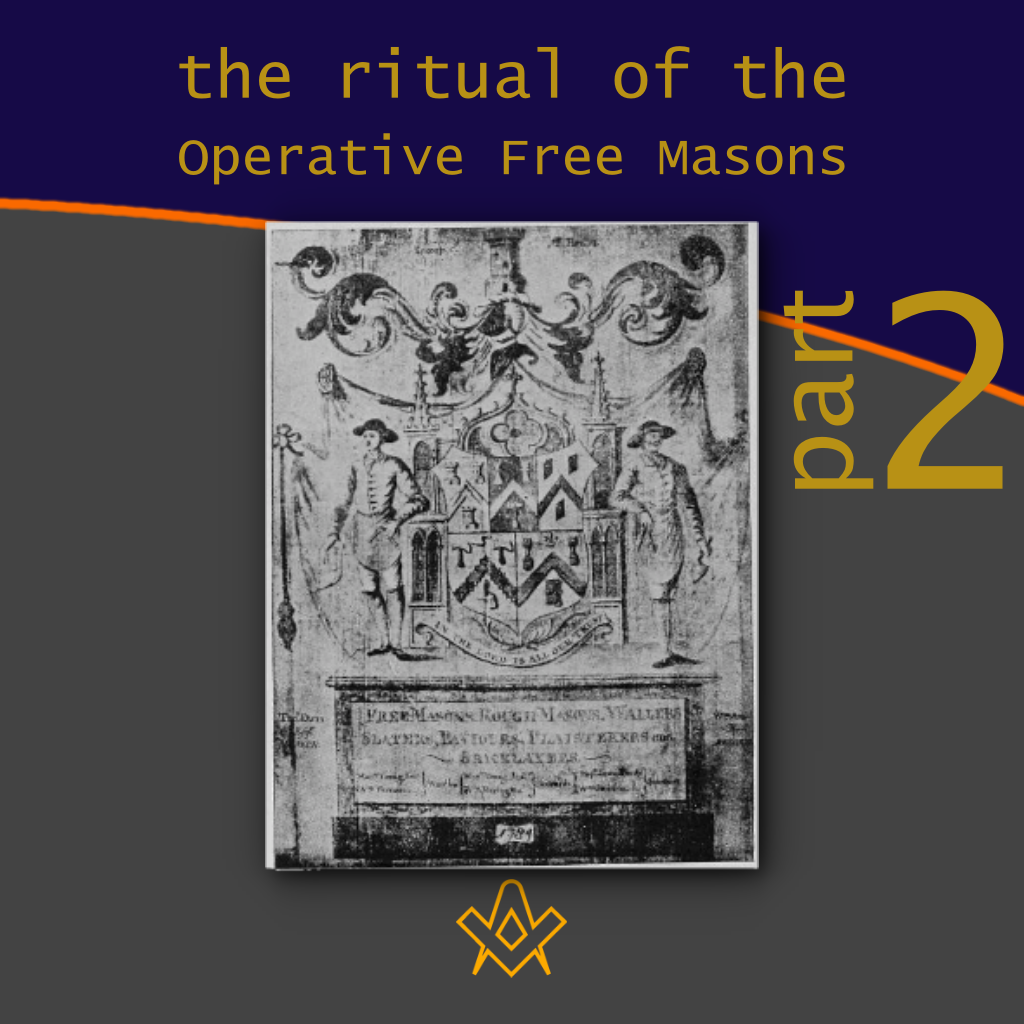The original paper was written, first, to prove that Speculative Free Masonry was derived from Operative Free Masonry; second, to give some account of the Operative Free Masons, of their Ritual, and of their customs.
By Thomas Carr, M.D., P. M. Honorary Member of the Guild of Operative Free Masons
If anyone doubts the fact that the formation of Speculative Free Masonry was due to and based upon Operative Free Masonry, it is quite easy to convince him of his error if he will only study the first Book of Constitutions.
This first Book of Constitutions is the original one which Anderson had been commissioned to prepare, in the following terms, “You are to order and arrange the ancient Gothic Constitutions upon a new and better system.” It was printed and published by the Authority of the Grand Lodge in 1723.
In spite of many alterations and new additions, and of its complete reversal at the Union in 1813, the present Book of Constitutions still shows unmistakably its operative origin.

Frontispiece – Book of Constitutions 1723
IMAGE LINKED: wikimedia Attribution 4.0 International (CC BY 4.0)
The Ancient Charge, given on page 1 of the present Book of Constitutions, dated 1909, are almost identical with the Antient Charges given in the first Book of Constitutions published in 1723.
The alterations are very few and unimportant and there are no alterations in Section 5, which is the one I am about to quote to prove the origin of Speculative from Operative Free Masonry. This Section 5 has for title “Of the Management of the Craft in Working” and you will notice the terms used are obviously and solely operative.
Of the Management of the Craft in Working
1. All masons shall work honestly on working days, that they may live creditably on holy days; and the time-appointed by the law of the land, or confirmed by custom, shall be observed.
2. The most expert of the fellow-craftsmen shall be chosen or appointed the master, or overseer of the lord’s work; who is to be called master by those that work under him. The craftsmen are to avoid all ill language, and ta call each other by no disobliging name, but brother or fellow; and to behave themselves courteously within and without the lodge.
3. The master, knowing himself to be able of cunning, shall undertake the lord’s work as reasonably as possible, and truly dispend his goods as if they were his own; nor to give more wages to any brother or apprentice than he really may deserve.
4. Both the master and the masons receiving their wages justly, shall be faithful to the lord, and honestly finish their work, whether task or journey; nor put the work to task that hath been accustomed to journey.
5. None shall discover envy at the prosperity of a brother, nor supplant him, nor put him out of his work, if he be capable to finish the same; for no man can finish another’s work so much to the lord’s profit, unless he be thoroughly acquainted with the designs and draughts of him that began it.
6. When a fellow-craftsman is chosen warden of the work under the master, he shall be true both to master and fellows, shall carefully oversee the work in the master’s absence, to the lord’s profit; and his brethren shall obey him.
7. All masons employed shall meekly receive their wages without murmuring or mutiny, and not desert the master till the work be finished.
8. A younger brother shall be instructed in working, to prevent spoiling the materials for want of judgment and for increasing and continuing of brotherly love.
9. All the tools used in working shall be approved by the grand lodge.
10. No labourer shall be employed in the proper work of masonry; nor shall free-masons work with those that are not free, without an urgent necessity; nor shall they teach labourers and unaccepted masons, as they should teach a brother or fellow.
The Speculative Ritual also gives proof of its derivation from the Operatives
(1) In the presentation of the Working Tools in each of the Three Degrees.
“As we are not all Operative Masons, but rather free and accepted, or speculative.”
(2) Operative Masons are referred to in the Lecture on the First Tracing Board when the Movable Jewels are described, and their uses explained.
(3) Operative Masons are described in the Official Lectures.
Lecture 1, Section 7. Emulation Working.
Q. How many sorts of Masons are there?
A. Two: Free and Accepted, and Operative.
Q. Which of those are you?
A. Free and Accepted.
Q. What do you learn by being a Free and Accepted Mason?
A. Secrecy, Morality, and Good Fellowship.
Q. What do Operative Masons learn?
A. The useful rules of Architecture, to hew, square, and mould stones into the forms required for the purposes of building and to unite them by means of joints level perpendicular, or otherwise; and by the aid of cement iron lead, or copper; which various operations require much practical dexterity and some skill in geometry and mechanics.
On January 6th, 1911, a historical note by W. Bro. John P. Simpson, B.A., P.A.G. Reg., was published by Grand Lodge, in which the author says:
“The Ritual of Freemasonry as far as the First and Second Degrees are concerned is in part no doubt derived from the ceremonies of the early Operative Guilds.”
Bro. Simpson would have been more accurate had he said, is mainly derived from the Operative ceremonies.
I would add so is the Third Degree, and also the Mark.
It would make the present paper too long to discuss this question of the Master Mason’s Degree now but I hope to publish a paper on “The Third Degree” at some future time.
Here it need only be said that the Third Degree was an afterthought as regards Speculative Masonry.
As formulated in 1717 and as laid down in the First Book of Constitutions in 1723, there was no Third Degree; a Mason only became a Master when he became Master of a Lodge.
The antient Charges in the present Book of Constitutions will suffice to make this quite clear; and this paragraph is the same today as it was in the First Book of Constitutions published in 1723. Section 4, paragraph 2.
“No brother can be a warden until he has passed the part of a fellow-craft, nor a master until he has acted as a warden, nor grand warden until he has been master of a Lodge.”
And the present Book of Constitutions has a footnote added to this Section which does not appear in the Book of 1723 but was first added in 1815.
“N. B. In antient times no brother, however skilled in the craft, was called a master-mason until he had been elected into the chair of a lodge.”
The Speculative Third Degree, as has already been stated, is however based on Operative Ritual, as it is an adaptation of the Annual Ceremony of the Operatives on October 2nd when they commemorate the slaying of the Third Master Hiram Abiff, a month before the Dedication of the Temple which they celebrate on October 30th.

The Ritual of the Operative Free Masons
By: Thomas Carr, M.D.
This work has been selected by scholars as being culturally important, and is part of the knowledge base of civilization as we know it.
This work was reproduced from the original artifact, and remains as true to the original work as possible.
Therefore, you will see the original copyright references, library stamps (as most of these works have been housed in our most important libraries around the world), and other notations in the work.
This work is in the public domain in the United States of America, and possibly other nations. Within the United States, you may freely copy and distribute this work, as no entity (individual or corporate) has a copyright on the body of the work.
As a reproduction of a historical artifact, this work may contain missing or blurred pages, poor pictures, errant marks, etc. Scholars believe, and we concur, that this work is important enough to be preserved, reproduced, and made generally available to the public. We appreciate your support of the preservation process, and thank you for being an important part of keeping this knowledge alive and relevant.
Recent Articles: masonic history
 Protestantism and Masonic Influence in Brazil Discover the untold story of how Freemasons helped Southern Americans immigrate to Brazil post-Civil War, fostering economic and educational growth in Santa Bárbara d’Oeste and Americana. Learn about their pivotal role in establishing Protestant churches and ensuring the secularity of the Brazilian State amidst a Catholic-dominated society. |
 Explore the proper use of the sacred word in Brazilian Freemasonry through an analysis of Masonic literature and Bible translations. Uncover the errors in pronunciation and the need for corrections to maintain liturgical coherence in rituals. Discover insights on Masonry, rituals, and the Hebrew word Boaz. |
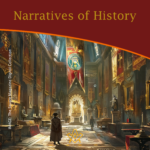 Narratives of History |
 A Very Royal Sesquicentenary |
 Unveiling the Enigma: Discover the Royal Society's Legacy and its Impact on Science. Delve into the fascinating history of the Royal Society, the prestigious UK academy shaping scientific progress since 1660. Explore its pivotal role in advancing knowledge, fostering collaboration, and unlocking the secrets of the universe. Prepare to be amazed! |
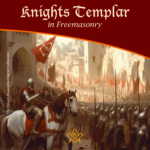 Knights Templar in Freemasonry Uncover the Mysteries of the Knights Templar in Freemasonry! Delve into the intriguing world where chivalry and symbolism intertwine. Discover the captivating rituals and ancient secrets behind the Knights Templar Masonic Orders. Explore the historical connection and delve into the enigmatic narratives that continue to fascinate enthusiasts today. Unveil the hidden truths now! |
 The Royal Arch stands as the rainbow of promise in the Ritual; it stands as the promise of the resurrection; of that which was lost and that it shall be recovered. The question arises as to whether the Master's Word was originally communicated in the Third Degree? On this point there is some diversity of opinion. Originally published in 1915, this insight into the Fourth Degree – the Holy Royal Arch – is as relevant today as it was over 100 years ago. |
 Unveiling the Mysteries of Druidism: Discover the Intriguing Connection with Freemasonry. Explore the ancient spiritual practice of Druidism and its fascinating ties to the enigmatic world of Freemasonry. Delve into the shared symbolism and rituals that have captivated minds for centuries. Unlock the secrets of these intertwined traditions today! |
 Uncover the legacy of freestone masons and their pivotal role in crafting medieval cathedrals. Discover the artistry behind their techniques, the hierarchy within their craft, and the enduring impact of their intricate carvings. A deep dive into the world of these master craftsmen awaits you! |
 Unearth the intriguing journey from Vincha Culture to Freemasonry. Discover how ancient building methods intertwine with modern Masonic philosophies. This exploration will shed light on the fascinating link between the Serbian term "shestarenye" and the symbolic significance of the compass in Freemasonry. |
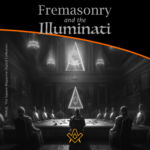 Freemasonry and the Illuminati Unravel the enigmatic world of Freemasonry and the Illuminati in our latest exposé. Dive into centuries-old mysteries, debunk conspiracy theories, and discover the truth behind these elusive societies. Are they puppet masters or mere myths? Join us as we dissect history and fact from fiction. |
 The Île des Templiers, or “Island of the Templars” lies within a leafy park in Paris. The execution site of Jacques du Molay, the last Grand Master of the Knights’ Templar bears a plaque with the epitaph ‘A cet endroit / Jacques de Molay / Dernier grand maître / de l'ordre du temple / a été brûlé le 18 Mars 1314’ (‘In this location / Jacques de Molay / Last grand master / of the order of the temple / was burned on 18 March 1314’) |
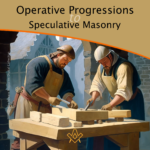 Operative Progressions to Speculative Masonry Both Operative and Speculative Masonry are an important part of the modern fraternity of Freemasonry, which combines elements of both traditions. Today, Freemasonry is a fraternity that is open to men of good character, who are interested in personal development and in making a positive contribution to their communities. |
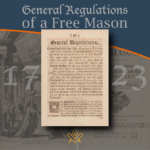 General Regulations of a Free Mason, 1723 General Regulations of a Free Mason as contained in Anderson's Constitutions of the Freemasons, published 1723. the Regulations are of great historical interest. Compiled by George Payne, the second Grand Master of the Premier Grand Lodge of England, they were printed in 1722/3, thus published just over five years after the formation of the Grand Lodge 1717. |
 The Genesis of the 1723 Book of Constitutions 2023, marks the three hundredth anniversary of the publication of the first printed Book of Constitutions of the Grand Lodge formally established in London two years previously. This is an anniversary whose significance extends beyond freemasonry. A paper by Andrew Prescott |
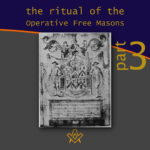 The Ritual of the Operative Free Masons - P3 Existing Operative Free Masons. The ritual I am about to refer, is that of "The Worshipful Society of Free Masons, Rough Masons, Wallers, Slaters, Paviors, Plaisterers, and Bricklayers." By Thomas Carr, M.D., P. M. Honorary Member of the Guild of Operative Free Masons |
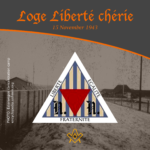 Liberté chérie was a Masonic Lodge founded in 1943 by Belgian Resistance fighters and other political prisoners at Esterwegen concentration camp. It was one of the few lodges of Freemasons founded within a Nazi concentration camp during the Second World War. |
 The Ritual of the Operative Free Masons - P2 If anyone doubts the fact that the formation of Speculative Free Masonry was due to and based upon Operative Free Masonry, it is quite easy to convince him of his error if he will only study the first Book of Constitutions. By Thomas Carr, M.D., P. M. Honorary Member of the Guild of Operative Free Masons |
 In 1881, Freemasonry rose from the ashes of a fire in the mining town of Kokomo, Summit County, Colorado. Corinthian Lodge No. 42, along with Kokomo, no longer exists but it holds the record of having been – at an elevation of 10,618 feet – the highest Masonic Lodge in the USA. |
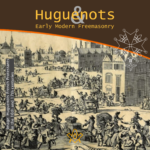 The Huguenots and Early Modern Freemasonry The Huguenots influence in the development of early modern Freemasonry at the time of the formation of the Grand Lodge in London around 1717 / 1723. |
 November is a month of reflection – perhaps due to the fact that we are getting close to the years' end – but also because Remembrance / Armistice Day (11 November) is a significant date in most countries' diaries. |
 Speculative Freemasonry, as practise by Grand Lodge of England, was officially born just over three hundred years ago, is today an international organisation, counting over six million members. It has been subjected to persecution, suppression, and abolition throughout its history. In its infancy, only a couple of decades after its official birth, it had already become a target. |
 The Ritual of the Operative Free Masons - P1 The original paper was written, first, to prove that Speculative Free Masonry was derived from Operative Free Masonry; second, to give some account of the Operative Free Masons, of their Ritual, and of their customs. By Thomas Carr, M.D., P. M. Honorary Member of the Guild of Operative Free Masons |
 American Fraternalism in the 19th and Early 20th Centuries The late 19th and early 20th centuries in the United States has been called the "Golden Age of Fraternalism." How did this come about and why was the idea of joining a fraternal organization so popular? We will explore this question and examine the regalia used by many fraternal organizations in this period. |
 Societas Draconistarum, meaning "Society of the Dragonists"– was a chivalric Order for selected nobility, founded in 1408 by Sigismund von Luxembourg, who through marriage became the King of Hungary (1387–1437) and later Holy Roman Emperor. The Order was fashioned after the military orders of the Crusades, requiring its initiates to defend the cross and fight the enemies of Christianity, in particular the Ottoman Empire. |
 The Perjured Free Mason Detected Was Samuel Prichard a perjured individual, or simply a misguided Freemason? Prichard's book "Free Masonry Dissected" published in 1730, is now used by many Masonic historians as a source of reference with regards to the introduction of the third degree into the Craft. But at the time it was published in 1730, it was not so well received by members of the Grand Lodge of England. |
 17th century and the Holy Royal Arch This article focuses on a period of transition between a point in time when we can safely and historically identify the first formation of what could be called as the ‘Royal Arch’ and the historical events that have preceded it. |
 Most Freemasons have heard the terms 'Operative' and 'Speculative' Masons, and this article helps to understand the difference: |
 Roberts' Constitutions of Freemasonry 1722 Published a year before Anderson's Constitutions, The Old Constitutions Belonging to the Ancient and Honourable SOCIETY OF Free and Accepted MASONS. Originally printed in London England; Sold by J. Roberts, in Warwick-Lane, MDCCXXII.(1722) |
 From 'Songs of religion and life', 1876 by John Stuart Blackie (1809-1895) |
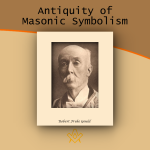 On the Antiquity of Masonic Symbolism Is the Symbolism of Masonry an inheritance derived from the old Masons who flourished before the era of the Grand Lodges (1717); or has it been borrowed from the Rosicrucians or others, after 1717? |
 Mason's Marks – from Egypt to Europe? Mason's marks have been a source of intrigue, not only to Freemasons but to historians and archaeologists. The use of simple pictograms have been employed for millennia by artisans to identify their work. But where did they originate and why? |
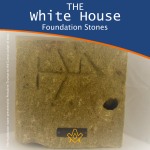 The White House Foundation Stones Further to the articles in our series on the history of the stone masons, we have a rather intriguing addition. During the 1950's renovation of the White House, President Truman retrieved more than 100 stone blocks with stonemasons marks. |
 What the Goose and Gridiron Tavern is in the ancient annals of London Freemasonry, The Green Dragon Tavern is to the memories of the Free-mason, of Boston and New England. |
 Auschwitz concentration camp: video photo article taken in 2013 |
 There are two things of importance happening this day - 27 January |
 Two approaches regarding the understanding of Freemasonry |
 Masonic Research in England c1930 An article which appeared in an American Masonic magazine, c1930 and which was reproduced in England, provoking a little controversy. |
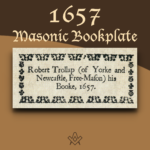 Masonic bookplates the ‘Brethren’s spiritual coats of arms and marks’ |
 The Unlawful Societies Act of 1799 Rebellious Freemasons and the 21st century |
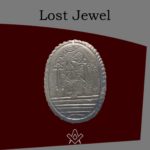 In 1912, Sarah Dowd of Dromore, Ireland, found a Masonic jewel dated 1517 - a date two hundred years before the establishment of Grand Lodge... |
 Freemasonry and Fascist Regime Interesting speech by the famous historian Prof. Aldo A. Mola, who links the fascist regime with the Masonic Associations. |
 Was famous Russian poet Alexander Pushkin a Freemason? And if so, was he a member of the lodge ‘for which all the lodges in Russia were destroyed’? |
 The Importance of Masonic Research Why is accurate - or authentic - Masonic research so important? The importance of making a daily advancement in Masonic knowledge is something that The Square is passionate about promoting. |
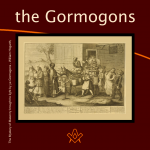 The Antient Noble Order of the Gormogons had a brief existence in the eighteenth century; they left few records or accomplishments, |
masonic knowledge
to be a better citizen of the world
share the square with two brothers

click image to open email app on mobile device



